

Study Buddhism. Understanding Buddhist Scriptures. Is there a Buddhist Bible? Not exactly. Buddhism has a vast number of scriptures, but few texts are accepted as authentic and authoritative by every school of Buddhism. There is one other reason that there is no Buddhist Bible. Many religions consider their scriptures to be the revealed word of God or gods. In Buddhism, however, it is understood that the scriptures are teachings of the historical Buddha - who was not a god - or other enlightened masters. The teachings in Buddhist scriptures are directions for practice, or how to realize enlightenment for oneself. Types of Buddhist Scripture Many scriptures are called "sutras" in Sanskrit or "sutta" in Pali. Sutras come in many sizes. Not all scriptures are sutras. Theravada and Mahayana Canons. Sito Ufficiale Istituto Lama Tzong Khapa. Comunità Dzogchen Merigar West. Centro Tenzin - Studi Tibetani. Istituto Samantabhadra.
Dharma. Key concept in Indian philosophy and Eastern religions, with multiple meanings Dharma (;[7] Sanskrit: धर्म, romanized: dharma, pronounced [dʱɐrmɐ] ( listen) (Pali: dhamma) (Tamil: aṟam)) is a key concept with multiple meanings in Indian religions, such as Hinduism, Buddhism, Jainism, Sikhism and others.[8] Although there is no direct single-word translation for dharma in Western languages,[9] it's commonly translated as “righteousness”, “merit” or “religious and moral duties” governing individual conduct.[11] In Hinduism, dharma is one of the four components of the Puruṣārtha, the aims of life, and signifies behaviours that are considered to be in accord with Ṛta, the order that makes life and universe possible.[12][note 1] It includes duties, rights, laws, conduct, virtues and "right way of living".[13] In Sikhism, dharma means the path of righteousness and proper religious practice And one's own moral duties toward God.[16] Etymology[edit]
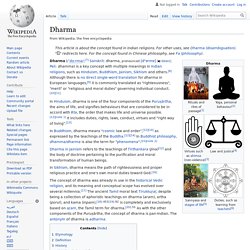
Noble Eightfold Path. Buddhist practices leading to liberation from samsara The eight spoke Dharma wheel symbolizes the Noble Eightfold Path In Buddhist symbolism, the Noble Eightfold Path is often represented by means of the dharma wheel (dharmachakra), in which its eight spokes represent the eight elements of the path.
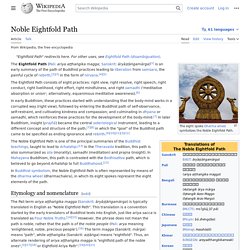
Etymology and nomenclature[edit] The Pali term ariya aṭṭhaṅgika magga (Sanskrit: āryāṣṭāṅgamārga) is typically translated in English as "Noble Eightfold Path". This translation is a convention started by the early translators of Buddhist texts into English, just like ariya sacca is translated as Four Noble Truths. Arya (Buddhism) The term is used in the following contexts: The Four Noble Truths are called the catvāry ārya satyāni (Sanskrit) or cattāri ariya saccāni (Pali).The Noble Eightfold Path is called the ārya mārga (Sanskrit, also āryāṣṭāṅgikamārga) or ariya magga (Pāli).Buddha's Dharma and Vinaya are the ariyassa dhammavinayo.In Buddhist texts, the āryas are those who have the Buddhist śīla (Pāli sīla, meaning "virtue") and follow the Buddhist path.Buddhists who have attained one of the four levels of awakening (stream-entry, once-returner, non-returner, arahant) are themselves called ariya puggalas (Arya persons).

In the context of the four noble truths, contemporary scholars explain the meaning of ārya as follows: The word "noble," or ariya, is used by the Buddha to designate a particular type of person, the type of person which it is the aim of his teaching to create. In the discourses the Buddha classifies human beings into two broad categories. Portail:Bouddhisme. This is about Buddhism. Bouddhisme Facile. Buddhism. Buddhism and Buddhist schools.
Buddhism. Wikipedia. BOUDDHISME - pearltrees voisins & sources perso. Buddhism. Bouddhisme. Bouddhisme. Buddhism. Chinese Buddhist Encyclopedia. Two people from Buddhism & Australia, Vello Vaartnou and Marju Broder represented Australia at the UC Berkeley PNC conference that was held on 16-18 August, 2016 in Los Angeles.
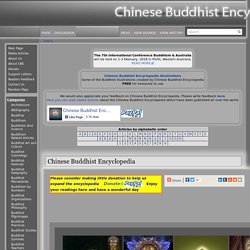
The PNC was founded at the University of California, Berkeley and it encourages scholars, academic institutions, and universities to collaborate and exchange their academic resources and research expertise. It is really wonderful, that Western Australia which is usually known for the mining boom, was represented by two people who deal with the academic aspect of Buddhism on international level. Until today, Western Australian universities do not have Buddhist studies at all. Prof. Emeritus Lewis Lancaster from UC Berkeley was the key speaker of the first International Conference Buddhism & Australia was very satisfied with the conference, academic presentations and organizational work. Two research papers on Buddhist history was presented at the PNC 2016 in Los Angeles this year. Buddhadharma. Dharma. Buddhism Archive. Buddhachannel : le portail du bouddhisme, de la santé et du bien-être. Himalayan Art Resources.
TIBETAN BUDDHIST GODS, BODHISATTVAS AND BUDDHAS. Maitreya The pantheon of gods in Tibetan Buddhism is derived mainly from Hinduism, Indian Buddhism and the Bon religion.

In many cases characteristics of gods from all three faiths are merged into a single god. A Buddhist god, for example, may have been derived from Hinduism and given characteristics of a Bon religion spirit. Moreover, the gods are intended to show the many sides of enlightenment: a particular god may have a wrathful, vengeful side as well as a peaceful and beneficent side. Dharma Haven: A Harbor from the Storms of Panic and Confusion. Ganachakra. Buddhism. Buddhism. Gandharan Art and Buddhism (Complete) Les Archives Berzin – Les Archives bouddhistes du Dr. Alexander Berzin – Page d'accueil. The Next Berzin Archives.
Canti di Milarepa sul non attaccamento a famiglia, amici e ricchezza — Study Buddhism. Milarepa aveva una sorella che insisteva affinché lui trovasse moglie e avesse una casa e figli, ma invece Milarepa se ne andò di casa e incontrò il suo maestro, Marpa.

Quando sua sorella venne a sapere che Marpa era sposato e che aveva casa e famiglia, cercò di fare pressioni su Milarepa. “Perché non fai come fa il tuo maestro?” Domandò lei. “È un errore se una volpe abbaia dove un leone ruggisce.” La vita di Gampopa — Study Buddhism. La prima volta che Gampopa udì il nome di Milarepa fu quando stava circoambulando uno stupa lungo una strada e udì per caso una discussione tra tre mendicanti.

Uno si stava lamentando continuamente della carestia presente nel paese e di come non avesse mangiato da tanto tempo. Buddhism. Buddhism. CONSCIENCE dans le bouddhisme. Buddhist philosophy. The Buddhist Nalanda university and monastery was a major center of learning in India from the 5th century CE until the 12th century.[1]
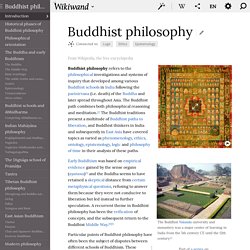
Study of Dependent Arising, dependent origination. Nagarjuna. Bouddhisme des Trois Rivières. Maître indien qui vivait aux environs du premier siècle de l’ère chrétienne.
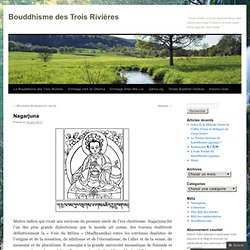
Nagarjuna fut l’un des plus grands dialecticiens que le monde ait connu. Ses travaux établirent définitivement la « Voie du Milieu » (Madhyamika) entre les extrêmes dualistes de l’origine et de la cessation, du nihilisme et de l’éternalisme, de l’aller et de la venue, du monisme et du pluralisme. Il enseigna à la grande université monastique de Nalanda et ses exposés sur la vacuité et d’autres sujets de la philosophie bouddhiste continuent aujourd’hui encore à être utilisés comme références et autorité pour la compréhension intellectuelle et la pratique contemplative. Like this: J'aime chargement… Cette entrée a été publiée dans Bouddhisme indien. Conventional and Ultimate Truth. Conventional and Ultimate Truths Ultimate truths of Buddhism are different from the conventional truths of everyday life.
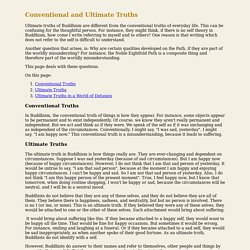
This can be confusing for the thoughtful person. For instance, they might think, if there is no self theory in Buddhism, how come I write referring to myself and to others? One reason is that writing which does not refer to the self is difficult to understand. The Two Truths of Buddhism and The Emptiness of Emptiness. There are two truths in Buddhism, conventional and ultimate truth. This penetrating insight dates back to the original Buddha. Understanding the two truths and the relationship between them is vital in seeing through the illusion of inherent existence and realizing emptiness or Śūnyatā.~ Nagarjuna’s philosophy of the Middle Way or Mahyamaka school of Buddhism shows how the two truths are different and yet despite this difference are critically the same.
Nagarjuna: le cose sono solo relazioni. Questo articolo è tratto da «la Lettura» #315, numero speciale a 64 pagine, in edicola fino a sabato 16 dicembre. Vita e opere di Nagarjuna (Douglas Berger) 2. Emanuela Magno - Dal pensiero alla vacuità. La critica Nagarjuniana e il trascendentale. Object reidentification and the epistemic role of attention. Science and Buddhism Agree: There is No 'You' There. By Lori Chandler Evan Thompson of the University of British Columbia has verified the Buddhist belief of anatta, or not-self.
Neuroscience has been interested in Buddhism since the late 1980s, when the Mind and Life Institute was created by HH Dalai Lama and a team of scientists. The science that came out of those first studies gave validation to what monks have known for years — if you train your mind, you can change your brain. As neuroscience has begun studying the mind, they have looked to those who have mastered the mind. While Buddha didn’t teach anatta to lay people, thinking it might be too confusing, the concept is centered on the idea that there is no consistent self. [W]hen there is no consistent self, it means that we don’t have to take everything so personally. It is useful to look at a video of yourself from the past, or read something you wrote years ago. Rebirth and Consciousness.
Was the Buddha an Atheist? "The Buddha was an atheist. " Writer Allan Badiner made this bald pronouncement in the midst of a conversation that spanned the wee hours of a cloudless Burning Man night. Sitting in a vast tent where, during the day, scores of partygoers had washed off their dust and grime in a plexiglass chamber, we discussed prevailing notions of a Buddhist godhead and, conversely, our mutual embrace of the religion in its secular form. I was most intrigued, though, by Badiner’s description of the Buddha as an atheist. I asked for sources. Allan’s first response: I would need time to do it, but there are passages from the Tripitaka that strongly indicate that the Buddha denied the existence of a creator god.
I responded with enthusiasm and persistence: "I like nontheist—thanks—but do send me the citation when you can. " Buddhist Inspirations & News » Are Manifestations & Mediums Of Bodhisattvas & Buddhas Around? We should respect all beings, even helpful humans, gods and ghosts. However, Buddhists only take refuge in the perfect Buddhas, Dharma and Aryasangha.
An interestingly phrased question arose recently – ‘Why do mediums not get any Buddha to answer their devotees’ questions?’ Buddhist Teachings on Fear and Fearlessness. Buddhist Monsters – Inside and Out. While there is no shortage of serene and benevolent buddhas, Buddhist folklore abounds with hell-raising zombies, vampires, ghouls, and ogres. But they’re not just the stuff of myth and legends. Depending on whom you ask, these ferocious monsters are thought to be as real as you or me, or serve as potent symbols of our less enlightened sides. Since reincarnation sits at the heart of Buddhist cosmology, we are never far from becoming the monsters we fear. In tantric traditions, practitioners are taught that subjugating outer demons is really about taming inner ones. Greco-Buddhism. Greco-Buddhism, sometimes spelled Graeco-Buddhism, refers to the cultural syncretism between Hellenistic culture and Buddhism, which developed between the 4th century BCE and the 5th century CE in the Indian subcontinent, in modern day Afghanistan, India, and Pakistan.
It was a cultural consequence of a long chain of interactions begun by Greek forays into India from the time of Alexander the Great, carried further by the establishment of the Indo-Greek Kingdom and extended during the flourishing of the Hellenized Kushan Empire. Greco-Buddhism influenced the artistic, and perhaps the spiritual development of Buddhism, particularly Mahayana Buddhism.[1] Buddhism was then adopted in Central and Northeastern Asia from the 1st century CE, ultimately spreading to China, Korea, Japan, Philippines, Siberia, and Vietnam. Historical outline[edit] Monks With Guns: Discovering Buddhist Violence. Les Rohingyas, peuple musulman apatride de Birmanie. En tête des pays les plus à risque: Myanmar, le Nigéria et le Soudan. Une partie des migrants qui arrivent sur les côtes européennes et, de l'autre côté du monde, sur les côtes indonésiennes, sont des minorités victimes de discriminations dans leur pays.
Ces persécutions de grande ampleur sont-elles des génocides? Risquent-elles à l'avenir de le devenir? Au-delà du douloureux débat sur la définition d'un génocide –des «actes commis dans l’intention de détruire, ou tout ou en partie, un groupe national, ethnique, racial ou religieux», selon la Convention adoptées par les Nations Unies en 1948–, le centre Simon-Skjodt pour la prévention des génocides a lancé un outil visant à prévoir le risque de massacres dirigés par l'État dans un pays.
Le projet, appelé «Early Warning», recherche les risques apparents d'extermination potentielle ou d'agressions contre des minorités, à partir des modèles conçus par les politologues et de sondages d'opinion. Karmic Management. Changing Your Mind. Bouddhisme. Buddhism. A Fistful of Sand. Imilla. Rivista Dharma - Fondazione Maitreya. BuddhaLine le bouddhisme et ses valeurs (amour, sagesse, compassion, paix, liberté, solidarité) Bouddha News - « La vie et le monde sont ce que nous en faisons. »
Buddhadharma - Home. FaceBuda. Theravada Buddhism. Padmasambhava: Consapevolezza Rigpa » Free Dharma Teachings Project for the benefit of all sentient beings – Insegnamenti di Dharma a beneficio di tutti gli esseri senzienti. Padmasambhava. Buddhism Today - Buddhist philosophy. Dharma Wheel - A Buddhist discussion forum on Mahayana and Vajrayana Buddhism. The Pali Tipitaka. Kalama Sutta. Chinese Fa-hsiang School Teaching. The Chinese Yogachara school was founded by Hsuan-tsang(600-664, Fig. 2), a Chinese pilgrim-translator, and his student Kwei-Ji(638-682), who systematized the teaching. Hsuan-tsang went to India and studied the doctrines derived from Dharmapala (? -507) and taught at the Vijnanavada center in Valabhi. When he returned to China (Fig.1, Great-Goose-Temple, Chan-Yan), he translated Dharmapala's Vijnapti-matratasiddhiand and many other works. His teachings mainly followed the line of Dharmapala.
The most important book of the school is the Vijnaptimatrata-siddhi (Chin., Cheng-wei-shih-lun, proof of Nothing-but-Cognition) by Hsuan-tsang, a compendious work in which the teaching of the school is presented in detail. The special characteristics of this school are its emphasis on meditation and a broadly psychological analysis. Digital Library - Buddhist Digital Resource Center. The Tibetan Book of the Dead - Evens Wentz. Buddhist Texts and Teachings. Sacred Texts: Buddhism. Buddhist Wisdom, Meditation, and Practices for Daily Life. Jayarava's Raves. Ad orientem vergere. Welcome! — International Dzogchen Community Webcast. Archivio testi. Dzogchen in Tibet: risveglio, illuminazione e corpo di luce.
Thinking – Secret Oral Teaching in Tibetan Buddhist Sects. Bön. Bön du Tibet - La vision est esprit 1/6.
Buddhism Archive. Bouddhisme. Buddhism. Rare Buddhist flower found under nun's washing machine. 'Axis Mundi' and the Sacred Mountains of the Earth. Buddhism's Diamond Sutra: The Extraordinary Discovery Of The World's Oldest Book. Bouddhanalyse.